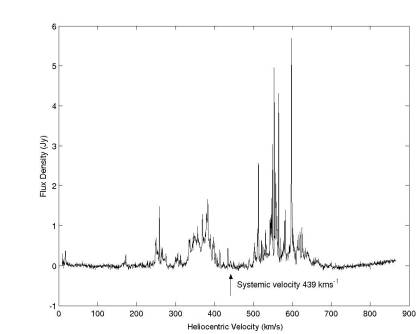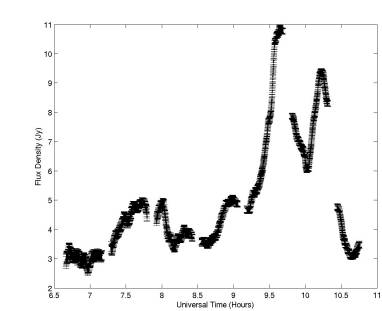Monitoring the Circinus galaxy H2O megamasers from Tidbinbilla
The Circinus galaxy is the closest Seyfert galaxy and also hosts the closest nuclear H2O megamasers (Gardner and Whiteoak, 1982). A typical spectrum (such as Figure 1) shows the classic triple-peaked spectrum, which is associated with masers located in a circumnuclear disk (e.g. NGC 4258, Nakai et al., 1993). VLBI imaging of the emission has revealed this to be the case, together with emission from other masers located in a nuclear outflow, with the maser spots spread out over a region about 70 milliarcseconds across (Greenhill et al., 2003).

Figure 1: Average spectrum of Circinus on 28, April 2003.
The Circinus galaxy megamasers are known to be variable on timescales of weeks and months with individual maser features having a lifetime of around one year. However, a far more rapid form of variability was first noted by Greenhill et al. (1997). Most of the masers observed showed some degree of variability over an hour while one feature displayed a doubling of its flux density over about 10 minutes. They examined three possible extrinsic mechanisms, interstellar scintillation (ISS) in the turbulent ISM, variability of background emission, or variability of a radiative pump. At the AGN Variability Workshop in 2001, Maloney argued that the rapid variations were caused by ISS. If the variability of the background emission were the cause, then the masers would need to be unsaturated, which is not believed to be the case, while radiative pump variability was considered unlikely because the lines were believed to be collisionally pumped (Maloney 2002). This left ISS
as the default explanation.
Since then our understanding of ISS has increased dramatically, mostly because of the discovery that rapid intra-day variability (IDV) at cm wavelengths of distant quasars is principally caused by ISS. (e.g. PKS 0405-385 (Kedziora-Chudczer et al., 1997), J1819+385 (Dennett-Thorpe and de Bruyn, 2000), PKS 1257-326 (Bignall, et al., 2003)). Two definitive tests of scintillation have been found - the presence of an annual cycle in the characteristic timescale of the variations and the detection of a time delay in the variability pattern recorded at two, widely separated telescopes. If either of these is detected, then it is an unequivocal result that the variability is due to ISS. This has been beautifully demonstrated in the case of the quasar PKS 1257-326, as described in the ATNF News from October 2002; a more detailed discussion of the observed time-delay and annual-cycle evidence can be found in Jauncey et al. (2003).
The possible scintillation of the Circinus megamasers is interesting for several reasons. Firstly, the scintillation is linked to their microarcsecond structure and observations could reveal differences between the size and evolution of the disk and outflow masers. Secondly, having a number of these near point-sources gives multiple lines-of-sight through the ISM over a small region, which could provide a way of probing the small-scale structure of the ISM.
To establish the nature of the variability, we have started a program of regular observations of the Circinus megamasers, using the Tidbinbilla 70-m antenna under a service-observing proposal. By measuring the characteristic timescale of individual features throughout the year, we are searching for annual cycles. This requires high time-resolution, high sensitivity observations with high spectral resolution, a combination that is presently only achievable using the Tidbinbilla antenna. At 22 GHz, it is roughly an order-of-magnitude more sensitive than the Parkes antenna. This is especially important, as currently the maser spectrum is significantly weaker than in previous observations. In observations last year, the strongest feature had a mean flux density of about 30 Jy. Now the strongest feature is a factor of five less, increasing our need for a highly sensitive antenna.
In our observations we are using a 64-MHz bandwidth divided into 2048 channels to cover all of the emission. To maximise the time spent in continuous observation of the Circinus megamasers, we have adopted an observing scheme that alternates 5-minute observations of a reference position with 30-minute observations of Circinus. This allows for good sampling of data combined with reliable bandpass calibration.
The observing program began on day 86 of 2003 and observations are to be made every month. Using archival data collected previously reveals that the characteristic timescale has obviously changed between these epochs although the sampling is still too sparse to make any definitive claims as to the cyclical nature. Also, the individual maser features do not all have the same characteristic timescales, suggesting that if scintillation is responsible, we are probably seeing some variability in the microarcsecond structure of the masers. For example, observations made on day 124 of 1996 revealed the most rapid variations yet with a peak-to-peak timescale of about 20 minutes while in Figure 2, a light-curve recorded on day 118, the timescale is closer to about 45 minutes.

Figure 2: An extreme scattering event? Light curve of the feature at v = 553 kms-1
Several dramatic examples of large and sudden variations have been observed such as shown in Figure 2. The amplitude of this feature rose by a factor of about 2.5 over half-an-hour, followed by another rapid inflection. The amplitude of these changes is unusual when compared with the other recorded data that displays relatively smooth and low amplitude variation. The observations did not show such an outburst in any of the other maser features. From our observations to date, it appears that the variations differ in each maser feature, suggesting that each feature differs in size and structure, or that each maser feature is probing an independent line of sight through the scattering medium.
If annual cycles are detected then we will have the unparalleled opportunity to study multiple lines of sight through the interstellar medium within a small area. If the nature of the variability is shown to be due to diffractive scintillations, then this will be the first detection for a non-pulsar source.
References
Bignall, H. et al., 2003, ApJ 585, 653
Dennett-Thorpe, J., de Bruyn, A., 2000, ApJ 529, L65
Gardner, F. and Whiteoak, J., 1982, MNRAS 201, 13
Greenhill, L. et al., 1997, ApJ 474, L103
Greenhill, L. et al., 2003, ApJ 590. Preprint at arXiv: astro-ph/0302533
Jauncey, D. et al., in `Radio-astronomy at the Fringe' 2003, eds J. Anton Zensus, Marshall H Cohen, H. and Eduaro Ros, ASP conference series 300, 199
Kedziora-Chudczer, L. et al., 1997, ApJ 490, L9
Maloney, P., 2002, PASA 19, 88
Nakai, N., Inoue, M., Miyoshi, M., 1993, Nature 373, 127
Jamie McCallum, University Of Tasmania / ATNF (jmccallu@utas.edu.au)
Jim Lovell, ATNF (Jim.Lovell@csiro.au)
Simon Ellingsen, University Of Tasmania (Simon.Ellingsen@utas.edu.au)
Dave Jauncey, ATNF (Dave.Jauncey@csiro.au)
